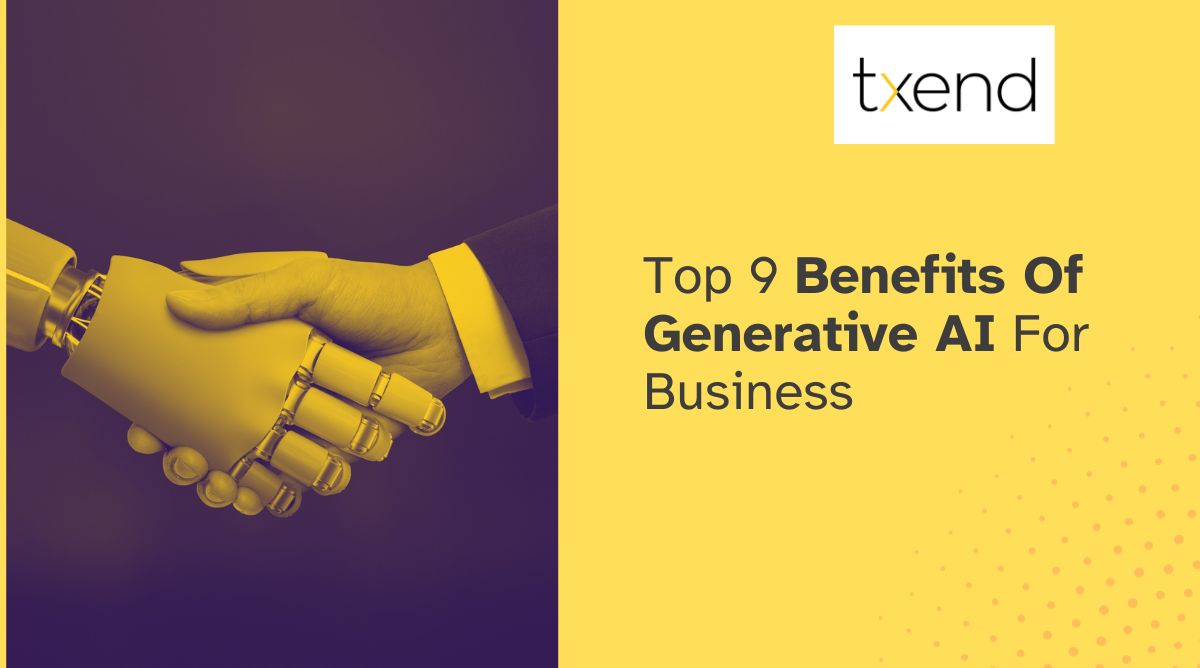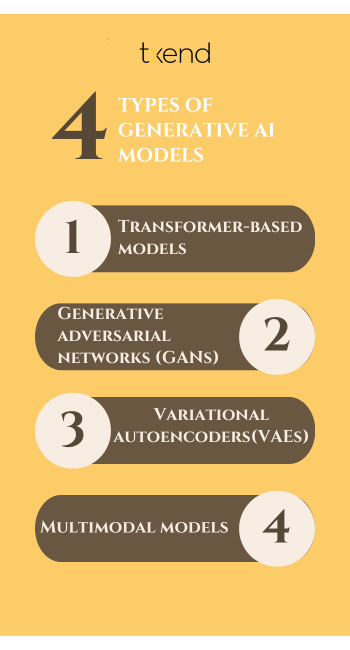
Generative artificial intelligence is a formidable new technology that could completely transform a wide range of industries. By learning from large datasets, generative AI models can create new and innovative content, such as images, text, code, and music.
There are several possible advantages of generative AI for companies, such as:
Increased Productivity And Efficiency:
Generative AI can automate many tasks that are currently performed by humans, freeing up employees to focus on more creative and strategic work.
Improved Product Quality And Innovation:
With the aid of generative AI, new products and services can be designed and developed, and the caliber of already-existing ones can be raised.
Reduced Costs:
Generative AI can help businesses to reduce costs by automating tasks and improving efficiency.
Enhanced Customer Experience:
Customers can receive more relevant and interesting content and have their experience personalized with generative AI.
New Opportunities For Business Growth:
Generative AI can enable businesses to create new products and services, and to expand into new markets.
In this article, we will discuss the top nine benefits of generative AI for business. We will also provide examples of how businesses are already using generative AI to gain a competitive advantage.

Key Takeaways
- Artificial intelligence that can produce original writing, music, graphics, and code is known as generative AI.
- A potent new technology called generative artificial intelligence (AI) has the ability to address many different business-related issues.
- Generative AI models come in a wide variety, each with unique advantages and disadvantages.
- Generative AI is a powerful technology with the potential to revolutionize many industries.
Generative AI
Artificial intelligence that can make new content, including writing, music, graphics, and code, is known as generative AI. It does this by learning from large datasets and identifying patterns and relationships between data points.
Once a generative AI model has been trained, it can be used to generate new content that is similar to the data it was trained on. Generative AI is a relatively new technology, but it has the potential to revolutionize many industries.
For example, generative AI is useful for:
Create New Products And Services:
It is possible to design and develop new goods with generative AI and services, such as new fashion designs, pharmaceutical drugs, and financial products.
Improve The Quality Of Currently Offered Goods And Services:
Generative AI can be utilized to enhance the quality of existing products and services, such as by generating more realistic images for video games or by creating more personalized marketing campaigns.
Automate Tasks:
Many tasks that are now completed by humans, like producing news stories, making marketing materials, and writing code, can be automated with the help of generative AI.
Personalize The User Experience:
With the help of generative AI, users of websites and applications can have more personalized experiences by receiving recommendations for goods or content that they are likely to find interesting.
Generative AI is still under development, but it is rapidly advancing. Future applications of generative AI should be even more inventive and revolutionary as these models grow in strength and sophistication.
9 Benefits Of Generative AI In Enterprises
Generative AI has the potential to offer a wide range of benefits to enterprises, including:
- Creativity amplification
- Hyper-personalization
- Data synthesis
- Adaptive learning
- Improved customer experience
- Time and cost savings
- Enhanced efficiency and productivity
- Realistic simulations
- Enhanced knowledge organization and discovery
1 – Creativity Amplification
Businesses may develop novel and inventive ideas, goods, and services with the aid of generative AI. For example, Marketing campaigns, customer service interactions, and innovative product designs can all be produced with generative AI.
2- Time And Cost Savings
Generative AI can automate many tasks that are currently performed by humans, freeing up employees to focus on more creative and strategic work.
For example, generative AI can be used to automate tasks such as content creation, data analysis, and customer service.
3 – Hyper-Personalization
Large-scale customer experience personalization is possible with generative AI. For example, Customers can receive personalized product and service recommendations using generative AI, according to their unique requirements and preferences.
4 – Enhanced Efficiency And Productivity
Businesses may increase productivity and efficiency by using generative AI to automate operations and streamline procedures. For example, generative AI can be used to automate tasks such as code generation, design, and testing.
5 – Data Synthesis
It is possible to create new data by combining current data using generative AI. This can be used to generate synthetic data to safeguard the privacy of real-world data or as training data for machine learning algorithms.

6 – Realistic Simulations
Realistic simulations of actual settings can be produced with the aid of generative AI. This can be useful for training employees, testing new products, and developing new strategies.
7 – Adaptive Learning
Generative AI can be used to develop adaptive learning systems that can tailor the learning experience to each individual user. This can be useful for training employees, students, and customers.
8 – Enhanced Knowledge Organization And Discovery
Generative AI can be used to organize and discover knowledge from large and complex datasets. This can be useful for businesses that need to make sense of large amounts of data, such as retailers, banks, and healthcare providers.
9 – Improved Customer Experience
Personalized and interesting interactions can be offered by energizing AI to enhance the consumer experience. Generative AI, for instance, can be used to build chatbots that can naturally and informatively respond to consumer inquiries.
Overall, generative AI has the potential to offer a wide range of benefits to enterprises. By automating tasks, amplifying creativity, and personalizing the customer experience, generative AI can help businesses to improve their efficiency, productivity, and profitability.
Is Generative AI The Solution?
A formidable new technology that has the ability to address many different business-related issues is generative artificial intelligence. However, it is important to note that generative AI is not a silver bullet. It is a tool that can be used to solve problems, but it is not a solution in itself.
The key to using generative AI effectively is to identify the right problems to solve. Generative AI is best suited for problems that involve creativity, data synthesis, and personalization.
Generative AI, for instance, can be utilized to:
- Generate new product ideas
- Design and develop new products and services
- Create personalized marketing campaigns
- Improve the quality of customer service
- Develop new forms of entertainment
If you are considering using generative AI to solve a problem in your business, it is important to first consider whether the problem is a good fit for generative AI. You should also consider the cost and resources required to implement generative AI, and the potential risks and challenges involved.
Here are some examples of how businesses are using generative AI to solve real-world problems:
- Google AI is using generative AI to develop new ways to improve the quality of Google Translate.
- Adobe is using generative AI to develop new tools for photographers and designers.
- Spotify is using generative AI to develop new ways to personalize the music listening experience for its users.
- Netflix is using generative AI to develop new ways to recommend movies and TV shows to its users.
- Drug companies are using generative AI to develop new drugs and treatments.
- Retailers are using generative AI to generate personalized product recommendations and to create marketing campaigns that are tailored to the individual needs and preferences of their customers.
These are just a few examples of how businesses are using generative AI to solve real-world problems. Future generative AI applications should be even more inventive and revolutionary as the technology develops further.
Types Of Generative AI Models
Generative AI models come in a wide variety, each with unique advantages and disadvantages. Among the most popular categories of generative AI models are:

Transformer-Based Models:
Transformer-based models are a type of neural network architecture that has been shown to be very effective for a variety of tasks, including natural language processing and machine translation.
Transformer-based models can also be used for generative AI tasks, such as text generation and image generation.
For Example:
Language translation, realistic text generation, and the creation of many forms of creative content are all accomplished with transformer-based models.
Generative Adversarial Networks (GANs):
GANs are a type of generative AI model that consists of two competing neural networks: a generator and a discriminator.
The generator creates new data, and the discriminator tries to distinguish between real data and the data generated by the generator. GANs have been shown to be very effective at generating realistic images and videos.
For Example:
GANs are being used to generate realistic images and videos, and to create new types of art and music.
Variational Autoencoders (VAEs):
Generative AI models that learn a latent space representation of data are called VAEs. VAEs can then use this latent space representation to generate new data.
Data augmentation, text generation, and image generation are among the tasks that VAEs are frequently utilized for.
For Example:
VAEs are being used to generate new images, text, and data, and to improve the quality of existing data.
Multimodal Models:
Multimodal models are a type of generative AI model that can learn from multiple types of data, such as images, text, and audio.
Multimodal models can then use this information to generate new data in any of the modalities that it was trained on. Multimodal models are often used for tasks such as video generation and machine translation.
For Example:
Multimodal models are being used to generate videos, translate languages, and create new types of interactive experiences.
In addition to these four types of generative AI models, there are many other types of generative AI models that have been developed. The best type of generative AI model to use for a particular task will depend on the specific task and the data that is available.
The field of generative AI is fast developing, and new models are being created on a regular basis. We may anticipate seeing even more ground-breaking and inventive uses of generative AI in the future as the technology develops.
Generative AI Vs Conversational AI: The Impact On Customer Experience
Generative AI and conversational AI are both powerful technologies with the potential to transform the customer experience. However, they have different strengths and weaknesses, and they should be used in different ways to achieve the best results.
Generative AI:
The Generative AI is best suited for tasks that involve creativity, data synthesis, and personalization.
For example, Personalized product suggestions, customer-specific marketing efforts, and the creation of new entertainment mediums can all be accomplished with the help of generative AI.
Conversational AI:
The Conversation AI is best suited for tasks that involve natural language interaction and customer support.
For example, Conversational AI can be used to build virtual assistants that assist clients with things like scheduling appointments and completing purchases, as well as chatbots that can respond to consumer inquiries in a conversational and helpful manner.
The Impact Of Generative AI And Conversational AI On Customer Experience
Generative AI and conversational AI can have a significant impact on the customer experience in a number of ways. For example, they can:
Improve personalization:
Generative AI and conversational AI can be used to personalize the customer experience at scale. Increased client happiness and loyalty may result from this.
Increase Engagement:
Generative AI and conversational AI can be used to create more engaging customer experiences. Increased customer lifetime value may result from this.

Reduce Costs:
Generative AI and conversational AI can be used to automate tasks and streamline processes. This can lead to reduced costs for businesses.
Improve Efficiency:
Businesses may increase productivity by using conversational and generative AI to automate repetitive operations and streamline workflows. This may result in lower expenses and better customer service.
Use Cases Of Generative AI
There are numerous possible applications for generative AI across numerous industries.
Here are a few examples:
Marketing And Sales:
Product recommendations, customized marketing campaigns, and innovative advertising formats can all be produced with the help of generative AI.
Content Creation:
Creating text, photos, films, and music with generative AI is possible. This can be used to create new types of content for marketing, education, and entertainment.
Product Development:
Using generative AI, one may create new products, enhance current ones, and spot untapped markets.
Customer Service:
Chatbots and artificially intelligent assistants that can respond to client inquiries, offer assistance and troubleshoot problems can be made with the help of generative AI.
Data Science:
Generative AI can be used to synthesize data, generate new features, and improve the performance of machine learning models.
Healthcare:
With the help of generative AI, illnesses can be identified more precisely, novel medications and therapies can be created, and patient care can be enhanced.
Manufacturing:
The application of generative AI can enhance quality control, streamline production procedures, and create innovative product designs.
These are just a few examples of the many potential use cases for generative AI. We may anticipate seeing even more ground-breaking and inventive uses of generative AI in the future as the technology develops.
Dangers And Limitations Of Generative AI
Generative AI is a powerful technology with the potential to revolutionize many industries. However, it is important to be aware of the potential dangers and limitations of generative AI before using it.
Dangers Of Generative AI
Misinformation and disinformation:
Generative AI can be used to create realistic-looking fake images, videos, and text. This can be used to spread misinformation and disinformation, which can have a negative impact on society.
Bias:
Generative AI models are trained on data, and if this data is biased, the model will be biased as well. This may result in the production of offensive or discriminating content.
Deepfakes:
Deepfakes are video or audio recordings that have been altered to make it seem as though someone is talking or doing something that they have never said or done. Generative AI can be used to construct these fakes. Deepfakes can be used to damage someone’s reputation or to spread misinformation.
Limitations Of Generative AI
Computational requirements:
The cost of computing power to train and operate generative AI models can be high. This can make them inaccessible to some businesses and organizations.
Data requirements:
To train, generative AI models need a lot of data. This data can be difficult and expensive to collect and prepare.
Lack Of Interpretability:
Generative AI models are often complex and difficult to understand. This can make locating and resolving possible model issues challenging.
How To Mitigate The Dangers And Limitations Of Generative AI
There are a number of steps that can be taken to mitigate the dangers and limitations of generative AI, such as:
Use Generative AI Responsibly:
It is important to use generative AI responsibly and to be aware of the potential dangers and limitations of the technology.
Use High-Quality Data:
Generative AI models should be trained on high-quality data that is free from bias.
Monitor Generative AI Models:
Generative AI models should be monitored for potential problems, such as bias and the generation of harmful content.
Develop Tools To Detect Generative AI Content:
Tools should be developed to help people to detect content that has been generated by generative AI models.
By taking these steps, we can help to ensure that generative AI is used for good and that its potential dangers are mitigated.
Overall, generative AI is a powerful technology with the potential to revolutionize many industries. However, it is important to be aware of the potential dangers and limitations of generative AI before using it. By using generative AI responsibly and taking steps to mitigate the dangers, we can help to ensure that generative AI is used for good.
FAQs
While standard AI is made to analyze data and make predictions, generative AI is capable of producing original material, such as literature, music, and graphics.
Generative AI can be particularly beneficial in industries that require creativity, innovation, and personalization, such as marketing, advertising, media, and entertainment.
AI can automate tasks, improve efficiency, and make better decisions.
Yes, generative AI can help in generating realistic images and content.
Generative AI can contribute to improving decision-making processes by generating new insights and perspectives, and by helping to identify and evaluate potential risks and opportunities.
Conclusion:
In conclusion, the incredible potential of Generative AI is transforming the way businesses operate and innovate. The primary keyword, “benefits of generative AI,” encapsulates the profound advantages this technology brings to the corporate landscape.
From the remarkable capabilities of generative adversarial networks to the diverse applications in various industries, the secondary keywords such as “generative AI for business” and “advantages of generative AI” underline the pivotal role this technology plays in modern enterprises.
The top 9 benefits of Generative AI, as explored in this article, reveal a world of opportunities for businesses. Not only does it enhance creativity and productivity, but it also allows for the automation of repetitive tasks, saving both time and resources.
The pros and cons of Generative AI highlight the need for responsible usage and continuous research to harness its full potential.
From generating lifelike images to assisting in data analysis and content creation, Generative AI offers a multitude of advantages. In the realm of product design, marketing, and customer service, it empowers businesses to stay competitive and stay at the forefront of innovation.
It’s certain that generative AI will continue to influence business in the future, completely changing how organizations interact with their clientele and adjust to the ever changing technological environment. By harnessing the “benefits of generative AI,” organizations can unlock new horizons, maximize efficient.
